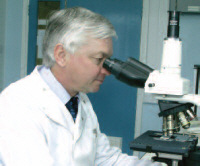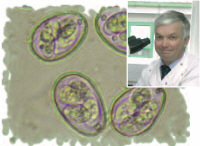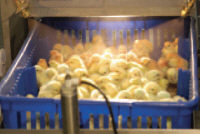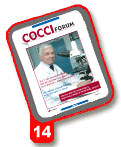In the eye of the beholder
Eimeria is the object of Dr. Ralph Marshall's fascinationTo an outsider, studying Eimeria for a living is a far-from-glamorous job, but parasitologist Dr. Ralph Marshall considers the object of his work attractive, mysterious, clever and challenging. He even has a favorite coccidial species - Eimeria tenella.
"Under the microscope, it has the
most beautiful shape of all the Eimeria
oocysts and a beautiful blue halo. It's as
simple as that. I just love it," he says.
The scientist heads up coccidiosis
research at the Veterinary Laboratories
Agencies (VLA), an entity initiated over
100 years ago in a small London office.
Today, VLA is located in Weybridge,
England, and is an internationally
recognized veterinary research center.
It is a reference laboratory for many
farm animal diseases and conducts
important studies for pharmaceutical
companies.
Marshall came to VLA in 1971 and
compares his work studying Eimeria
to his favorite hobby - bird-watching.
"There are a lot of analogies between
the two," he says. "I love walking out
in the field and being able to identify
a bird. And I love being able to
look down a microscope and identify
a parasite. Both have taught me the
skill of observation, which is key to
parasitology."
Observation has also enabled him
to witness an array of interesting developments
over the years in the field of
coccidial research.
'Brave new world'

When anticoccidial chemicals were
developed and marketed, it appeared
to herald a "brave new world," he says.
Then the problem of Eimeria resistance
to anticoccidials started to develop.
Marshall spent several years studying
the problem.
"Slowly we realized that these little
parasites were winning. It was good
fun working out the mechanisms of
how the parasites were getting resistant
to drugs," he says.
"We managed to develop lots of
resistant strains here in the lab. We
actually had one that got hooked on an
anticoccidial. If we gave this particular
Eimeria strain to chickens that were fed
a particular anticoccidial, the parasites
lived. If we withdrew the drug, the parasites
died. The drug seemed to keep
the parasites alive," Marshall says.
Recalling the advent of ionophores,
he says, "The idea behind these
drugs was not to wipe out the parasites
completely."
Around that time, however, Marshall
experienced a time warp when he
moved to another department within
VLA and temporarily lost track of coccidiosis
research. He returned to his
beloved field in the 1990s to find a
newcomer on the scene: the attenuated
coccidiosis vaccine Paracox, which has
dominated his life for the past decade.
The poultry industry had difficulty
adjusting to the notion of vaccinating
poultry to control coccidiosis. "There
was a total change in mindset from
being told you have to get a drug to kill
this parasite to then being told that you
don't want to use a drug, you can use
a vaccine instead," he says. "That was a
difficult concept for producers to
grasp."
Today, coccidiosis vaccines are
widely accepted in the breeder sector
and in several countries, their use is
growing in other segments of the market,
including broilers and free-range
laying hens, Marshall says.
Testing sprayed vaccine

Eimeria photo courtesy of Dr. Ralph Marshall.
Marshall has also been involved in testing
new methods of administering coccidiosis
vaccines. About 6 years ago, he
headed up VLA's assessment of
Schering-Plough Animal Health's
SprayCox II, a spray cabinet technology
for application of Paracox-5 to broilers.
"We set up a cabinet that was like a
giant sort of construction kit," he says.
"We had about 700 or 800 birds that
were vaccinated in large groups at
once. Then we challenged them with
field strains of Eimeria given at times
ranging from about 2 to 7 weeks after
vaccination. It was very successful and
we published the results."
More recently, Marshall has been
involved in testing the efficacy of the
spray cabinet for administration of
Paracox-8 for broiler breeders as well
as free-range egg layers, a development
that would bring added convenience to
farmers vaccinating birds in this segment
of the market.
For the study, birds were challenged
with seven Eimeria species. The outcome
is being determined by performance
results such as weight gain as well
as oocyst output and lesion scores. At
this writing, the preliminary results
looked good, he says.
Another important aspect of
Marshall's work with coccidiosis has
been development of an anticoccidial
sensitivity test to determine the level of
resistance among Eimeria parasites
recovered from the field. Birds on various
anticoccidials are challenged with
Eimeria field isolates and, again, performance
and oocyst output and lesion
scores will be used to reveal the sensitivity
of each Eimeria species to the various
anticoccidials tested.
Studies in other countries, he notes,
have demonstrated that resistant field
strains of Eimeria can be replaced with
the strains of Eimeria in the vaccine,
which are still sensitive to anticoccidials.
In other words, the vaccine can be
used to revitalize a producer's anticoccidial
program or it can replace the
use of anticoccidials, which is especially
important for growers raising antibiotic-
or drug-free birds.
At this writing, Marshall planned to
initiate sensitivity testing soon. Similar
testing has been conducted elsewhere
in Europe and the United States, but
never before in the UK, he says.
"Our studies will demonstrate if the
experience in the UK is likely to be the
same as it has been elsewhere," he
says.
Eimeria's economic impact

Throughout the interesting twists and
turns that have occurred during his
career, Marshall never forgets the economic
importance of his work.
Eimeria and resulting coccidiosis
has been estimated to cost the UK
alone £35 million (51.5 million Euros or
$66.2 million) a year considering production
losses and the cost of anticoccidial
control, he says. "With inflation,
it's probably a lot more since that
figure was established. The disease
causes a huge, huge cost to poultry distributors."
Eimeria, Marshall points out, is tenacious.
If you leave coccidia lying on the
ground in a chicken house, particularly
in the UK where it's often cool and
damp, it can survive for weeks and
may resist normal cleaning and disinfection
processes. With short turnaround
times, this can present a problem
for subsequent flocks. "It can be a
very difficult bug to get rid of. The
industry has found ways to contain
Eimeria, but it comes with a price.
"We'll never know all there is to
know about coccidia. These parasites
are just too clever for us," he says.
There are also hidden costs from
coccidiosis that aren't even readily
apparent, Marshall says. Anticoccidial
resistance has resulted in a subclinical
challenge that knocks the edge off performance.
Trials in the UK have shown
that when broilers are vaccinated for
coccidiosis with Paracox-5 and that
challenge from resistant coccidia is
eliminated, growth appears to blossom
and there's an increase in live weight.
"Considering that we grow 800 million
broilers in the UK annually, better control
of coccidiosis through vaccination
could have a huge impact, but producers
here, understandably, want hard
data," he says.
Marshall's work with vaccines has
taken on new importance due to the
movement toward drug-free poultry
production. The arsenal of anticoccidials
is shrinking and, he predicts,
ionophore use may be reconsidered in
the future.
Producers still using anticoccidials
need to make the most of the ones that
are still available or they need to find
alternatives. If they know they can successfully
revitalize or replace their anticoccidial
program with vaccination,
"that would be great," Marshall says.
In addition to changes prompted by
the drug-free movement, animal welfare
trends are also affecting poultry
producers. More birds will be freerange
and the sizes of cages and the
number of birds reared on floors are
growing, which could increase the coccidial challenge. That's why Marshall
says vigilance is needed not only to
keep up with coccidiosis disease patterns,
but also to find improved control
strategies that help producers minimize
losses due to Eimeria.
Apart from VLA, Marshall plans to
be vigilant about traveling with wife
Jackie, adding to the list of 40 countries
they've visited so far.
His most exciting trip was a safari in
Botswana - hands down. "The animals,
birds and ecology are fantastic,"
he says.
Asked what observation in the bird
world compares to the excitement of E.
tenella's blue halo, though, and
Marshall says it was finding a nesting
pair of black stilts in New Zealand,
probably the rarest shorebird wader in
the world.
"There are only about 80 of these
birds left in the world, and I observed
a breeding pair," he says.







